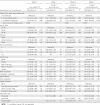Bacterial vaginosis assessed by gram stain and diminished colonization resistance to incident gonococcal, chlamydial, and trichomonal genital infection
- PMID: 21067371
- PMCID: PMC3053135
- DOI: 10.1086/657320
Bacterial vaginosis assessed by gram stain and diminished colonization resistance to incident gonococcal, chlamydial, and trichomonal genital infection
Abstract
Background: We sought to assess the relationship between bacterial vaginosis (BV) assessed by Gram stain and incident trichomonal, gonococcal, and/or chlamydial genital infection.
Methods: This longitudinal study included 3620 nonpregnant women aged 15-44 years who presented for routine care at 12 clinics in Birmingham, Alabama. Participants were assessed quarterly for 1 year. Vaginal smears were categorized by the Nugent Gram stain score (0-3, normal; 4-6, intermediate state; 7-10, BV). Pooled logistic regression was used to estimate the hazard ratios for the comparison of trichomonal, gonococcal, and chlamydial infection incidence in participants by Nugent score at the prior visit. Participants were censored at their first visit with a positive test result for trichomonal, gonococcal, and/or chlamydial infection.
Results: Of the 10,606 eligible visits, 37.96% were classified by BV and 13.3% by positive detection of trichomonal, gonococcal, and/or chlamydial infection. An intermediate state or BV at the prior visit was associated with a 1.5-2-fold increased risk for incident trichomonal, gonococcal, and/or chlamydial infection (adjusted hazard ratio [AHR] for intermediate state, 1.41 [95% confidence interval {CI}, 1.12-1.76]; AHR for BV, 1.73 [95% CI, 1.42-2.11]; P= .058 for trend). Estimates were similar for trichomonal-only, gonococcal-only, and chlamydial-only infection outcomes.
Conclusion: BV microbiota as gauged by Gram stain is associated with a significantly elevated risk for acquisition of trichomonal, gonococcal, and/or chlamydial genital infection.
Figures



References
-
- Sewankambo N, Gray RH, Wawer MJ, et al. HIV-1 infection associated with abnormal vaginal flora morphology and bacterial vaginosis. Lancet. 1997;350(9077):546–550. - PubMed
-
- Sobel JD. Is there a protective role for vaginal flora? Curr Infect Dis Rep. 1999;1(4):379–383. - PubMed
-
- van deWijgert JH, Mason PR, Gwanzura L, et al. Intravaginal practices, vaginal flora disturbances, and acquisition of sexually transmitted diseases in Zimbabwean women. J Infect Dis. 2000;181(2):587–594. - PubMed
-
- Gupta K, Stapleton AE, Hooton TM, Roberts PL, Fennell CL, Stamm WE. Inverse association of H2O2-producing lactobacilli and vaginal Escherichia coli colonization in women with recurrent urinary tract infections. J Infect Dis. 1998;178(2):446–450. - PubMed
-
- Wiesenfeld HC, Hillier SL, Krohn MA, Landers DV, Sweet RL. Bacterial vaginosis is a strong predictor of Neisseria gonorrhoeae and Chlamydia trachomatis infection. Clin Infect Dis. 2003;36(5):663–668. - PubMed
Publication types
MeSH terms
Substances
Grants and funding
LinkOut - more resources
Full Text Sources
Other Literature Sources
Medical

